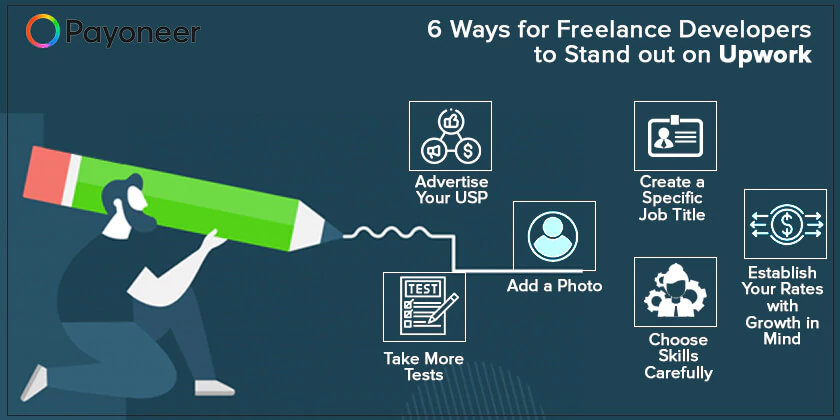6 Ways for Freelance Developers to Stand out on Upwork
Upwork (formerly oDesk) offers web developers an opportunity to brandish their profiles in front of thousands of potential clients. Your portfolio, core competencies, and other data receives far more visibility on Upwork than on your personal website or social media profile, but only if you create an Upwork presence that forces potential clients to notice…


1. Take More Tests
Clients want to feel confident in hiring polished, proven professionals. They don’t want to risk their projects on a web developer who claims to know six scripting languages inside and out, but actually just took an HTML class in high school 15 years ago. Upwork makes available tests in various competencies so freelancer developers can prove their experience and expertise. Take as many of these tests as possible, from HTML5 and CSS to Internet Marketing and Computer Aptitude. Make sure your tests illustrate the widest possible range of your skills.2. Advertise Your USP
Your USP (unique selling proposition) is just as important as that of an international corporation. It communicates, in as few words as possible, why your web development skills and talents surpass those of the competition. List your most impressive skills and identify the results you’ve attained for previous clients. For example, instead of just stating that you have 10 years of experience in WordPress development, mention the fact that 80 percent of your clients have achieved at least four times greater web traffic as a result of your efforts on their behalf. Place your USP at the start of your profile so it receives maximum visibility. It’s the first thing potential clients will see.3. Add a Photo
Adding a professional photo increases your chances of securing jobs through Upwork and other networks. In fact, LinkedIn reports that profiles with photos are “11 times more likely to be viewed.” This same concept translates to Upwork. Avoid photographs of you holding your children, cuddling with your dogs, or running down the beach in your swimwear. You want prospects to picture you working for them, not indulging in your private life. For more tips on uploading a professional photo, read 8 Things to Consider When Selecting your Freelance Profile Photo.4. Create a Specific Job Title
With thousands of professionals competing for web development projects, you’ll need a specific and attractive title if you want to stand out. While it might be accurate to type “Web Developer” into that field in your profile, something more descriptive will garner more attention. For example, you might call yourself a “Web Development Strategist” if you focus on creating new and innovative code for the websites you develop. It tells clients that you take more creative control over your projects.5. Establish Your Rates with Growth in Mind
If you’re just starting out on Upwork, you might want to advertise lower rates until you build a reputation. Once clients see a pattern of demonstrated success, you’ll find it easier to charge more for your services. Rates constitute a personal decision, so don’t feel obligated to lower your normal rate by a hefty margin. Instead, take into consideration as many factors as possible, including the average rates in the industry. To better understand what freelancers in your industry are making, check out Payoneer’s Freelancer Income Survey.6. Choose Skills Carefully
Upwork allows freelancers to select 10 skills to advertise on their profiles. Avoid redundant skills or skills that lack significant interest, but consider adding skills that label you as unique. For example, if you’ve received training in a new web development software program, you might want to include it. Other web developers can’t compete if they haven’t received the same training. Starting your career on Upwork as a web developer starts with your profile. You’ll stand out if you give it as much attention as you would devote to your resume or to a meeting with a client.Related resources
Latest articles
-
Planning to hire employees in France? Here’s a quick guide
Looking to hire employees in France for your U.S. company? Learn about employment in France and how Payoneer Workforce Management makes it simple to hire in France.
-
Planning to hire employees in Spain? Here’s a quick guide
Are you looking to hire employees in Spain? Learn about employment in Spain and how Payoneer Workforce Management can help American companies hiring in Spain.
-
How to hire employees in the Netherlands
Looking to hire employees in the Netherlands for your U.S. company? Learn about employment in the Netherlands and how Payoneer Workforce Management can help hire in the Netherlands.
-
How to hire employees in Australia
Looking to hire employees in Australia for your US company? Learn about employment in Australia and how Payoneer Workforce Management makes it easy to hire in Australia.
-
Planning to hire employees in Germany? Here’s a quick guide
Are you looking to hire employees in Germany? Learn about hiring in Germany and how Payoneer Workforce Management can help U.S. companies hiring in Germany.
-
Planning to hire employees in the Philippines? Here’s a quick guide
Wondering how an American company hires employees in the Philippines? Our guide covers how to hire employees in the Philippines and how we can help.
Disclaimer
Nothing herein should be construed as if Payoneer Inc. or its affiliates are soliciting or inviting any person outside the jurisdiction where it operates/is licensed to engage in payment services provided by Payoneer Inc. or its affiliates, unless permitted by applicable laws. Any products/services availability are subject to customer’s eligibility. Not all products/services are available in all jurisdictions in the same manner. Depending on your eligibility, you may be offered with the Corporate Purchasing Mastercard, issued by First Century Bank, N.A., under a license by Mastercard® and provided to you by Payoneer Inc., or the Payoneer Business Premium Debit Mastercard®, issued and provided from Ireland by Payoneer Europe Limited under a license by Mastercard. The Payoneer Business Premium Debit Mastercard® cannot be used at merchants or ATMs in Hong Kong or for HKD payments. If you are located in the EEA, all Payoneer Services will be provided to you by Payoneer Europe Limited, trading as Payoneer and regulated by the Central Bank of Ireland.
The information in this document is intended to be of a general nature and does not constitute legal advice. While we have endeavored to ensure that the information is up to date and correct, we make no representations or warranties of any kind, express or implied, about the completeness, accuracy, reliability or suitability of the information. In no event will we be liable for any loss or damage including without limitation, indirect or consequential loss or damage, or any loss or damage whatsoever incurred in connection with the information provided.















